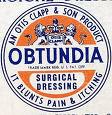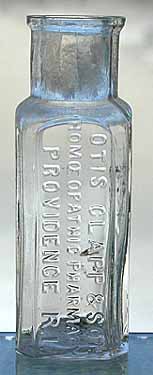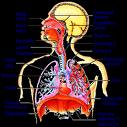Otis Clapp 1820 - 1886
March 21, 2008
 Otis Clapp 1820? - 1886 was
a
Swedenborgian (based
on the works of Emanuel
Swedenborg), a
homeopathic
pharmacist
and Professor of Pharmacy at the
homeopathic Boston University School of
Medicine.
He was also a major publisher of
Swedenborgian
literature, and he ran one of the major homeopathic
apothecaries
in Boston and whose business is still going strong
today (John S. Haller, The History of
American Homeopathy: the academic years,
1820-1935.
(Routledge, 2005). Page 205).
Otis Clapp 1820? - 1886 was
a
Swedenborgian (based
on the works of Emanuel
Swedenborg), a
homeopathic
pharmacist
and Professor of Pharmacy at the
homeopathic Boston University School of
Medicine.
He was also a major publisher of
Swedenborgian
literature, and he ran one of the major homeopathic
apothecaries
in Boston and whose business is still going strong
today (John S. Haller, The History of
American Homeopathy: the academic years,
1820-1935.
(Routledge, 2005). Page 205).
Otis Clapp was the major publisher of James John Garth Wilkinson’s publications in America, and he names his son James Wilkinson Clapp 1847
- ? (Emeritus Professor of Homeopathic Pharmaceutics at Boston University School of Medicine) after his life long friend.
 Otis Clapp
was a New
Churchman
(Unitarian) and he first
purchased the publishing company of J Allen in
1833
and in 1843 Otis Clapp wrote an article called The Family
Sphere
about Fourierism.
(William Clapp Jnr and
Robert
Clapp
were also publishers in Boston at this time).
Otis Clapp
was a New
Churchman
(Unitarian) and he first
purchased the publishing company of J Allen in
1833
and in 1843 Otis Clapp wrote an article called The Family
Sphere
about Fourierism.
(William Clapp Jnr and
Robert
Clapp
were also publishers in Boston at this time).
Otis Clapp opened his pharmaceutical and apothecary shop opened in 1845 to become one of the major homeopathic apothecaries in eastern America, selling all sorts of remedy kits and medicine chests (many of the old bottles of homeopathic remedies are now in museums and avidly collected) and of course many books on homeopathy:
Otis Clapp in Boston was a major homeopathic apothecary and Swedenborgian publishing house… James John Garth Wilkinson’s translations of Emanuel Swedenborg, which were distributed by Otis Clapp in Boston.
Otis Clapp became a major distributor of Swedenborgian writings and a strong advocate of homeopathy, and when it was attacked by Oliver Wendell Holmes, it was Otis Clapp who published all three rejoinders.
See http://www.otisclapp.com/company-history/ Otis Clapp & Son, Inc. began in 1840 when Otis Clapp opened the doors of his small retail pharmacy in Bostons Back Bay. His varied background included publishing and public service when he served as a member of The Massachusetts House Of Representatives. He became one of the founders of The Massachusetts Institute of Technology (M.I.T.) and The Home For Little Wanderers, one of the first orphanages.
From 1862-1875, Otis even served as The Federal Collector of Internal Revenue! His appointment, which was personally signed by President Abraham Lincoln, is still displayed by the company in its Canton, MA headquarters. As described by a turn-of-the-century, handwritten, and now faded Otis Clapp research diary, the early 70s brought Otis’s son, Dr. J. Wilkinson Clapp, to the company as a partner (the writer was referring to the 1870s as opposed to the 1970s).
Dr. Clapp, a research scientist first, and a businessman second, devoted a great deal of his time to the Boston University Medical School where he was a professor of pharmacy. His contributions to the school included numerous research projects, the installation of operating room facilities, and student nursing accommodations. Dr. Clapp was the son part of Otis Clapp & Son, Inc. During the early l900s, Lowell T. Clapp, grandson of the founder, joined the firm to bring a third generation to the original company. Lowell, a pharmaceutical chemist and bacteriologist, designed a new and completely equipped laboratory for research on Bostons Newbury Street. Experts in the biological and physical sciences were employed to bring balance to the companys work in bacteriology, physics and chemistry. In this facility, Otis Clapp formulations were compounded and pharmaceutical preparations tried, tested and approved. Some of these original formulations, such as Obtundia, still exist today with updated improvements.
Otis Clapp was a member of the Massachusetts Emigrants Aid Company and he was also instrumental in the founding of the Boston Female Medical College:
See http://homeoint.org/cazalet/histo/newengland.htm The first (homeopathic) medical college in history was the Boston Female Medical College, founded in 1848 by Samuel Gregory.
In 1852 it changed its name to the New England Female Medical College. And in 1873, it merged with another homeopathic medical school, Boston University School of Medicine… Founded by Dr. David Thayer (homeopath and member of the Massachusetts state legislature), Otis Clapp (famous homeopathic pharmacist), and Daniel B. Stedman.
The faculty at Harvard opposed the bill that was submitted to the state legislature to accept the charter of the college.
His varied background included publishing and public service when he served as a member of The Massachusetts House Of Representatives. He became one of the founders of The Massachusetts Institute of Technology (M.I.T.) and The Home For Little Wanderers, one of the first orphanages.
From 1862-1875, Otis even served as The Federal Collector of Internal Revenue! His appointment, which was personally signed by President Abraham Lincoln, is still displayed by the company in its Canton, MA headquarters.
As described by a turn-of-the-century, handwritten, and now faded Otis Clapp research diary, “the early 70’s brought Otis’s son, Dr. James Wilkinson Clapp, to the company as a partner” (the writer was referring to the 1870s as opposed to the 1970s).
Dr. Clapp, a research scientist first, and a businessman second, devoted a great deal of his time to the Boston University School of Medicine where he was a Professor of Pharmacy. His contributions to the school included numerous research projects, the installation of operating room facilities, and student nursing accommodations.
Dr. Clapp was the “son” part of Otis Clapp & Son, Inc. During the early l900’s, Lowell T. Clapp, grandson of the founder, joined the firm to bring a third generation to the original company. Lowell, a pharmaceutical chemist and bacteriologist, designed a new and completely equipped laboratory for research on Boston’s Newbury Street. (Thomas Clapp was a Professor of Chemisty and William E Clapp was also a chemist in Boston at this time)
Experts in the biological and physical sciences were employed to bring balance to the company’s work in bacteriology, physics and chemistry. In this facility, Otis Clapp formulations were compounded and pharmaceutical preparations tried, tested and approved.
Some of these original formulations, such as Obtundia, still exist today with updated improvements. continue reading:
Otis Clapp also published books by homeopath Anna Temple Lovering Hints at Domestic Practice and Home Nursing_, _Conrad Wesselhoeft’s A Lecture on Homoeopathy Before the Members of the Boylston Medical Society, The Homœopathic Pharmacopœia of the United States by the American Institute of Homeopathy, John Adams Tarbell’s Homoeopathy Simplified: Or, Domestic Practice Made Easy, Timothy Field Allen’s Boenninghausen’s Therapeutic Pocket Book, Friedrich August Gunther’s New Manual of Homeopathic Veterinary Medicine, C F Hoffendahl’s Homeopathic Treatment of Cholera, and the Quarterly Homoeopathic Journal, New England Medical Gazette. A Monthly Journal of Homeopathic Medicine, Surgery, and the Collateral Sciences, Charles Julius Hempel’s Materia Medica; Or, Provings of the Principal Animal and Vegetable Poisons, Jabez P Dake’s Therapeutic Methods. An Outline of Principles Observed in the Art of Healing, Nehemiah Wheeler Rand and John Prentice Rand’s Random Rimes: Medical and Miscellaneous which included poems to Whittier, a class poem “The Homeopath, ” delivered at the New York Homeopathic Medical College, and many other books on homeopathy including Trituration Tablets: Dosimetric, Moulded and Compressed : Also, Hypodermic… , Practical Guide to Homoeopathy: For Family and Private Use, Compiled from … , and many other books.
Otis Clapp was a member of an illustrious family, including Thomas Clapp, Professor of Chemistry and a New York Physician, his son James Wilkinson Clapp, two homeopathic Emeritis Professors and many more:
There was Col. Daniel, member of the provincial Congress, 1774, who for more than thirty years was Register of Deeds in Worcester County. What is best of all, these men left the public service with a good name. And do not flatter yourselves a good name is cheaply gained on our Cousin Eben’s impartial record.
Though he says he has heard of but one as ever arrested for crime, I have read on those pages written only for his own eye, here and there certain descriptive phrases that we’ll not repeat outside of the family!
Military life has proved attractive, and there is scarcely a military title but what has been worn by some member of the family. On the day of the battle of Lexington, five of our name enlisted in one company in Dorchester ; seven from that town served through the Revolutionary war; eleven there joined Lieut. Clapp’s company for reinforcing the army in 1780, and five Dorchester Clapps enlisted for the suppression of Shay’s rebellion.
In the French and Revolutionary wars, and in that of 1812, the Dorchester and Northampton branches of the family were fully represented, and several lost their lives. I need not say that many hearts with us to-day ache for those out of their homes, who lately fell in defense of our imperilled Union.
 Otis Clapp’s
son James Wilkinson Clapp
(?named after James John Garth
Wilkinson
as Henry James
Snr’s
son Wilky was?) was homeopathic Emeritus Professor of
Pharmaceutics and a faculty
member of the Boston
University School of
Medicine.
Otis Clapp’s
son James Wilkinson Clapp
(?named after James John Garth
Wilkinson
as Henry James
Snr’s
son Wilky was?) was homeopathic Emeritus Professor of
Pharmaceutics and a faculty
member of the Boston
University School of
Medicine.
 Herbert Codman Clapp
1846 - was a homeopath
who practiced in
Boston
and he practiced with Samuel
Gregg,
the pioneer of homeopathy in New England. He was a faculty
member and Professor of the
Diseases of the Chest at the
Boston University School of
Medicine.
Herbert Codman Clapp
1846 - was a homeopath
who practiced in
Boston
and he practiced with Samuel
Gregg,
the pioneer of homeopathy in New England. He was a faculty
member and Professor of the
Diseases of the Chest at the
Boston University School of
Medicine.
Herbert Codman Clapp was born in Boston, Massachusetts, January 31, 1846, son of John Codman Clapp and Lucy A. (Blake) Clapp. On the paternal side he is descended from Nicholas Clap, who came from Dorchester, England, in 1633, and was one of the early settlers of Dorchester, Massachusetts, now a part of Boston.
His elementary education was acquired at the Roxbury Latin School, and his literary education at Harvard College, from which he received his A. B. degree in 1867, and A. M. in 1870.
In the latter year he graduated from the Harvard Medical School with the degree of M. D. Subsequently he studied and practiced with Dr. Samuel Gregg of Boston, the pioneer of homœopathy in New England.
In 1876 he established and conducted until 1878 the chest department of the college branch of the Homœopathic Medical Dispensary for the treatment of the diseases of the heart and lungs, and for the clinical instruction of medical students in these diseases.
For many years he was chairman of the executive committee of the board of trustees of the dispensary. He has been for a long time specialist and consultant in diseases of the chest at the Massachusetts Homœopathic Hospital.
Also, since its opening, in 1878, he has been one of the two visiting physicians who have had the supervisory charge of the treatment of patients at the Massachusetts State Sanatorium for Incipient Consumptives, at Rutland, Massachusetts, where the percentage of apparently cured cases has been very large.
He has long held the position of consulting physician to the Cullis Consumptives’ Home, for advanced cases. Dr. Clapp was instructor in auscultation and percussion in the Boston University School of Medicine from 1877 to 1885, and since 1885 has been professor of diseases of the chest in the same institution.
He is ex-president of the Massachusetts Homœopathic Medical Society, of which he was treasurer for twenty years, receiving from the society in recognition of his services at the end of that period a very handsome gold watch.
He is also ex-secretary, ex-treasurer and ex-president of the Boston Homœopathic Medical Society, member of the National Association for the Study and Prevention of Tuberculosis, member of the Council of the Boston Association for the Relief and Control of Tuberculosis, member of the American Institute of Homœopathy, the Massachusetts Surgical and Gynecological Society, the Hughes Medical Club, the Viginti and the American Social Science Association.
In 1879, 1880 and 1881 he was the editor of the __New England Medical Gazette.
He published in 1878 a book entitled __Auscultation and Percussion, for Physicians and Students, which went through thirteen editions; and in 1880 another book, __Is Consumption Contagious?
This was before Robert Koch’s discovery of the tubercle bacillus.
Dr. Clapp wrote the sections on Physical Diagnosis,_ Phthisis Pulmonalis_ and Tuberculosis in Arndt’s System of Medicine, three volumes, 1885.
He married, January 31, 1878, Mary O. Richardson, of Brooklyn, New York, whose uncle, Dr. Edward T. Richardson, was an eminent homœopathic physician. Three daughters have been born of this marriage : Theodora W., Lucy B. and Marion L. Clapp.
Henry Clapp was also a supporter of Fourierism and a close friend of Walt Whitman. Within a few months after the publication of Leaves of Grass, Whitman’s staunch ally, Henry Clapp, was exposed in a scandalous expose of New York’s Free Love League.
Henry Clapp, like the lesbian minister Phebe Ann Coffin Hanaford, was a member of the Nantucket Quaker Coffin family, which included suffragist Lucretia Mott.
By the time _Leaves of Grass_ was published, either Clapp or a former Quakeress named Mary Gove Nichols had engineered the Quaker doctrine of “God within” or “the inner light” into a defense of individual conscience in the conduct of sexual relationships.
Henry Clapp served as right-hand man to the architect of American Fourierism, Albert Brisbane. Both Fourier socialism and the spiritualist movement had great appeal to radical Quakers, and both were scandalously linked in the public eye with the licentiousness of Free Love…